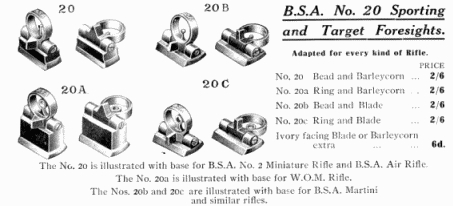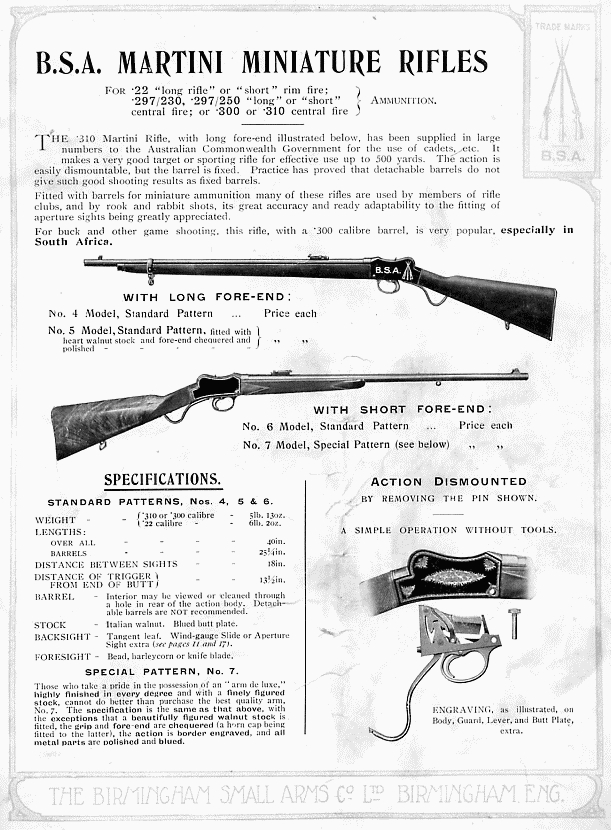
Please be aware that some specialist imagery may take time to load.
This site is designed for dedicated researchers on desktop or tablet, not ideal for mobile browsing.
The BSA Model No.4 rifle was put into production circa 1909 around the same time as the smaller actioned No.6 civilian style target and sporting models.
The example below is the Model No.4b Australian Commonwealth Cadet Pattern

The Model No.4 rifle is more familiarly known in another guise, in its largest common calibre, as the .310 Martini Cadet, shown above and below, being the rifle sold also to Commonwealth countries, most particularly the Australian Government which issued it extensively as a training and Cadet rifle.

It will be seen below that the No.4 Model formed the basis from which Models No.5, and Model Nos.6 and 7 evolved, although the Model No.6 changed somewhat in build and purpose over the ensuing years. These models subsequently led, via the Models 8 and 9, and military orientated Models 10 and 11, to the famous Model No.12, the lightweight Model No.13 and finally the Models No.15 and Model No.12/15, post World War II, before developing into the last of the line - the Martini-International series of TARGET RIFLES .
The Model 4a was as the standard open-sighted No.4, but with the addition of BSA's own No.8 aperture folding rear-sight
 .....
..... `
`
and either their No. 20 or 20a fore-sight.



.....
The Model No.5 was simply an upgraded Model No.4 with heart walnut stock, chequered fore-end, and specially polished wood furniture.
The high level of success of the .310 calibre miniature Martini rifles, in their heyday, can be ascertained by reading the details of the "Plater Incident" and other information on the page for the W.W. Greener miniature Martini rifles. Greeners produced many military martini rifles, including a Cadet model of their own, also sold to Australia and some foreign states; see reproduction below of a page from his pamphlet circa 1912

The 1909 Birmingham Small Arms Co. brochure advertised the first production rifles on the page shown below

By 1912, the catalogue advised that the above Martinis, hitherto available in .22 "Short" or "Long Rifle" rimfire; and .297/.230" "Long" or "Short" (Morris) and the most common .310" centre-fire calibres, then offered a new option of .32/20 - the nowadays readily available cartridge, the case for which has often been modified by hand-loaders shooting the .310" Cadet Pattern Rifles. Newly manufactured .310" cases have been obtainable for some time, but can be relatively expensive and, occasionally, have been in short supply.
The No.5 Model was as the No.4, with nearly full length, military style woodwork, but stocked in heart walnut, chequered and polished. The No.6 was a short fore-end standard rifle and, over the next few short years, the No.6 became practically the standard light-weight target rifle until the introduction of the No.8 Model.
The Model No.7 was B.S.A.'s top specification small action Martini rifle, with figured walnut stocking and engraved action body. It was also possible to order special engraving - at significantly extra cost.
Below is the 1932 advertisement for the later Model No.6 rifle

Returning, from this minor diversion, to the .310 calibre BSA Cadet rifle, we post images below of the action of such a rifle of the contract for Government of New South Wales, Australia, which rifle returned to its home country of manufacture little short of a hundred years later.
 ...................
...................
The images below illustrate the comparatively large calibre and pistol-like .310 cartridge used mainly for training.
 Similar
style rounds were also commonly used for sporting purposes.
Similar
style rounds were also commonly used for sporting purposes.
The rifle was also available in .22 in. rimfire and .297/.230 Morris centre-fire calibres.
A comparative image of these rimmed rounds is also shown, approximately twice actual size.
 From
top to bottom:
From
top to bottom:
.22 Rim Fire Short
.22 Rim Fire Long Rifle
.297/.230 Morris Short Centre Fire
.297/.230 Morris Long Centre Fire
.310 in. Centre Fire
The cannelure of the heeled .310 bullet, containing the barrel lubricating compound, can be clearly seen.
The action body width is the same nominal one inch ( fractionally under) and 4¼" o/a length that as used for the Model Nos. 6 through 11. The falling block is just under three-quarters of an inch wide and two and five-sixteenths inches in length.
Left: the cocking indicator is evident in the cut-out on the LHS of the action's falling block;
The rifle is uncocked, and therefore the indicator is lying flush with the top of the action block and body. When the action is cocked, the lever protrudes above, giving tangible evidence that the rifle is in a potentially dangerous condition - particularly valuable in the absence of any safety catch facility. The Cadet cocking indicator is the miniature calibre equivalent of the tear-drop cocking indicator, familar to all users of the Martini-Henry, Metford and Enfield full-bore service rifles, on the RHS of those actions. The small-bore rifle's cocking indicator design carried forward with the introduction of the wider 1³/16 inch action of the Model No.12 and until after the 1914-18 war. The additional width of the later action was entirely in the action body side walls, the falling block width remaining nominally the same.
Whilst later wide-actioned BSA Martini models were devoid of the cocking indicator, Vickers Armstrong resurrected the system with their own Vickers Martini-actioned Target Rifles in the 1920s and continued its use right through until the mid 1930s with the Vickers Champion rifle.
 Alongside
are two images, one of the butt-stock markings for New South Wales Cadet rifle,
Alongside
are two images, one of the butt-stock markings for New South Wales Cadet rifle,
and the other showing the military style fore-end with sling swivel and the fore-sight block.
.............................
Finally, we show an image of the Cadet rifle (with the same configuration as the No.4 Model) in comparison with the BSA Model 8 based Model No.10 in that rifle's own quasi semi-military furnished style.

Top: the BSA Cadet rifle; bottom: the BSA Model No.10.
A short and interesting article, by Ian Barger of New South Wales, and written specifically about the Australian Cadet rifle, was originally available on the Digger History site, but is no longer there. We have taken the liberty of showing it here as a pdf.
_______________
A recent enquiry (Sept. 2025) asked for detail of the rear sling swivel of the .310 Cadet rifle.
The swivel has a ratchet-style wood-screw thread of 10 tpi.
Dimensions can be scaled from the image below.

Return to: TOP of PAGE
See this website's Raison d'être